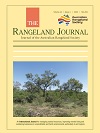RJ23030Applying two remotely-sensed methods for monitoring grazing impacts in the Australian arid zone
The rainfall experienced in Australia’s arid rangelands can be so unpredictable that remote-sensing methods depending on regular growing seasons to detect grazing impacts are ineffective. We tested two methods that assess ground cover in the wettest and driest years respectively, across a 32-year period, for detecting trends in impacts. Despite limitations created by spatial variability and small paddocks, the methods provide an objective means of assessing trends in management impacts independent of arid Australia’s erratic climate.
RJ23030 Abstract | RJ23030 Full Text | RJ23030PDF (5.8 MB) Open Access Article





